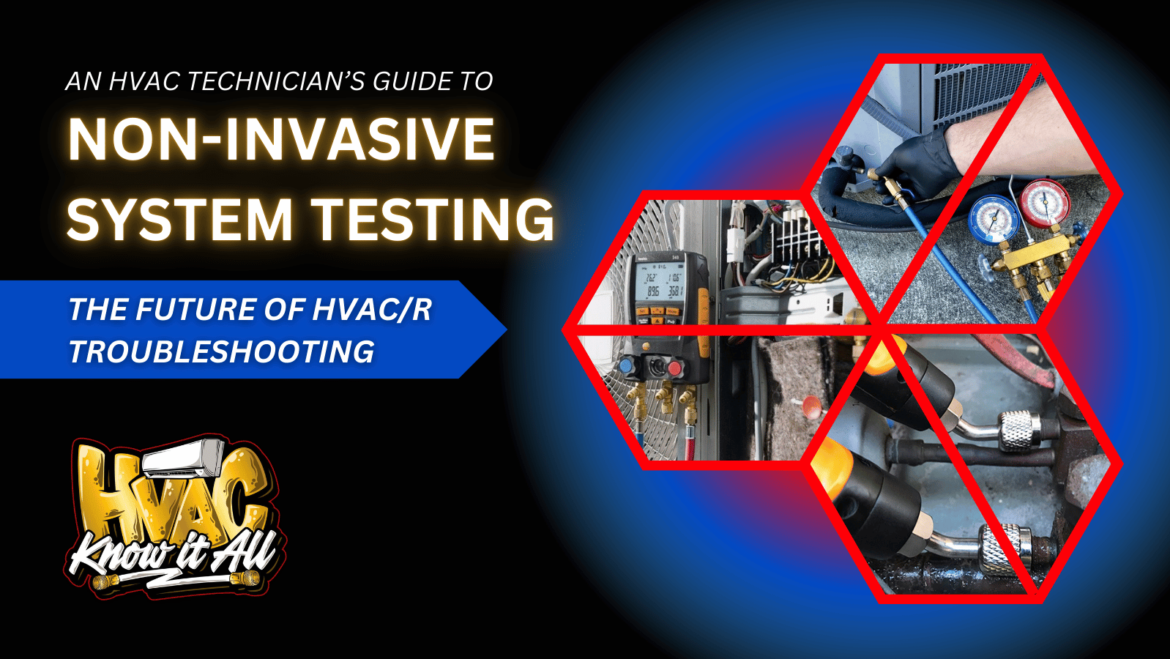The Future of HVAC/R Troubleshooting: Non-Invasive System Testing
Picture, if you will, the classic aesthetic that comes to mind when we think of heating and air technicians. If you’re anything like me, that picture includes a coverall-clad technician, next to a condenser with their back hunched over a set of refrigerant gauges desperately trying to understand the relationship between the numbers on the screen and the health of the system.
Now, what if I were to tell you, that common view may soon change with gauges being seen as little as twice in the system’s entire life? That’s right, I’m talking about non-invasive system testing.
Understanding Non-Invasive System Testing
Non-invasive system testing is what we call the act of testing and troubleshooting a system’s performance without ever connecting gauges. With the use of temperature clamps, thermistors, basic equations, and airflow diagnostic tools; paired with a deep understanding of the refrigerant cycle and pressure temperature relationships we are capable of diagnosing even intricate issues within a system using a less intrusive process than we’ve been known to use in the past.
Different Approaches to Non-Invasive Testing
There are several established methods for non-invasive testing, each with its own strengths:
1. The ANSI/ACCA 310 Method
Standard 310 is a new installation standard for unitary HVAC systems, mostly applicable for new installations. You can find their NIST protocol in Section 8.4 of the official standard document. This standardized approach uses normalized blower CFM and temperature measurements to verify proper system operation. It requires:
- Return air dry bulb and wet bulb temperatures
- Condenser entering temperature
- Suction line temperature
- Liquid line temperature
2. The Mowris Non-Invasive Temperature Diagnostic (NTD) Method
Recently outlined in the 2024 ACEEE study on Lifecycle Refrigerant Management, this method focuses on a non-invasive temperature diagnostic (NTD) testing technique which was patented by Robert Mowris in 2023. This approach factors in:
- Design Temperature Differences (DTD)
- Temperature relationships between components
- Power consumption verification
- Comprehensive system benchmarking
3. The measureQuick “Benchmarking” Approach
This method combines the best of both worlds. Pioneered by Jim Bergmann, measureQuick’s “benchmarking” feature allows you to save a “known good” snapshot of the system performance in the cloud, which then saves time and resources in every future site visit. Here’s some of the highlights of measureQuick’s Benchmarking process:
- System-specific snapshots get saved to the cloud
- Real-time performance analysis
- Automated calculations based on system profile
- Historical tracking of system performance
I was fortunate enough to interview about NIST on the measureQuick YouTube Channel:
Why is it important to ‘gauge up’ to a system only when absolutely necessary?
1. Refrigerant Loss
One of the primary advantages of non-invasive testing is the ability to identify problems without the risk of losing refrigerant. In an average service call, a residential system typically loses 5% of its charge just from connecting gauges! This may not seem like a lot but when we factor in how many visits a system will need in its lifetime, and a technician gauging up each time that number certainly adds up. Loss of refrigerant affects the performance, health and efficiency of a system leading to more frequent service calls, and customer discomfort. Thus, we must do what we can to keep as much of our charge within the closed system as possible.
2. Environmental Protection
How we service HVAC systems has a major impact on the environment, and “gauging up” accounts for 50% of all refrigerant venting. This excerpt from the “Refrigeration Lifecycle Management” Study linked above was an eye-opening read:
From the There are about 2 billion AC and HP systems in the world or approximately 1 system for every 4 people. Total refrigerant in cooling equipment worldwide (“installed refrigerant bank”) is 24 billion MTCO2e – equivalent to annual emissions of 5 billion gas-powered cars (CCL 2022). Refrigerant venting damages the ozone layer and produces approximately one ton of equivalent carbon dioxide (CO2) emissions per pound of hydrochlorofluorocarbon (HCFC) refrigerant R-22 and hydrofluorocarbon (HFC) R-410a. Reducing refrigerant venting will help reduce global warming from 0.5°C to 0.04°C by year 2100 (DNV GL. 2021)
3. Minimal Disruption
Traditional HVAC diagnostics often require significant downtime, leading to discomfort for occupants in residential or commercial settings. Non-invasive checks can be performed with minimal disruption, allowing systems to remain operational while evaluations are conducted.
4. Enhanced Safety
There are a lot of safety risks that technicians face each day in our field. It’s important to take as many of those risks out of the equation as possible to improve the quality of work and life of technicians. Non-invasive methods protect technicians from potentially dangerous exposure to harmful chemicals and allow us to perform servicing of the system in a low-danger work zone.
Understanding Temperature Relationships
One key to successful non-invasive testing is understanding basic temperature relationships. For a typical system at 400 CFM per ton:
- The evaporator coil should be about 35°F colder than the return air
- Modern condensers typically run about 20°F above ambient temperature
- Target superheat or subcooling can be calculated based on these relationships
For example, if your return air is 75°F: 75°F – 35°F = 40°F evaporator coil temperature Add your target superheat (let’s say 13°F) = 53°F expected suction line temperature If you’re within ±5°F of this target, you’re likely in good shape.
Implementing Non-Invasive System Checks
To effectively implement non-invasive system checks, HVAC professionals should follow the following steps, in this approximate order:
1. Invest in Advanced Diagnostic Tools
- Quality temperature clamps and probes
- Airflow measurement devices
- Digital power meters for amp and watt readings
- Smart probe systems when possible
2. Proper Training
Regular training on non-invasive techniques ensures technicians can perform thorough evaluations without defaulting to connecting gauges. Understanding pressure-temperature relationships is crucial.
3. Establishing a NIST Routine
Making non-invasive checks part of every service call helps build confidence in the process. The more we perform these checks, the more we learn about system behavior without breaking the sealed system.
4. Benchmarking for Future Reference
As we’ve discussed in previous articles about proper system commissioning (like Jamie Kitchen’s piece on adaptive vs. fixed expansion valves), establishing baseline readings during installation is crucial. This data becomes invaluable for future non-invasive diagnostics.
When To Use Gauges
Let’s be clear – there are times when connecting gauges is necessary:
- Initial system commissioning
- Major repairs requiring refrigerant recovery
- When non-invasive tests indicate significant issues
- System disposal
Walking Through a Non-Invasive System Check
Let me walk you through a real-world example of non-invasive testing on a 3-ton residential split system with a TXV. I’ll show you exactly what I look for and how I interpret the readings.
Before We Start: The Setup
- Outdoor temperature: 85°F (measured in the shade near condenser)
- System: 3-ton residential split system, R410A, TXV
- Tools needed: Temperature clamps, psychrometer (for wet/dry bulb), airflow measurement tool
Step 1: Verify Airflow
First Always start with airflow – it’s the foundation of everything else. I use my TrueFlow grid to measure actual CFM:
- Target: 1200 CFM (400 CFM/ton × 3 tons)
- Actual measured: 1150 CFM
- This is within 5% of target, so we’re good to proceed
Step 2: Check Your Design Temperature Differences
For a 13-14 SEER system, we expect:
- Evaporator DTD: 35°F
- Condenser CTOA (Condensing Temperature Over Ambient): 20°F (If you’re working on a higher SEER system, that CTOA might be closer to 15°F)
Step 3: Take Your Measurements
Here’s what I measured:
- Return air (dry bulb): 75°F
- Return air (wet bulb): 63°F
- Supply air: 55°F
- Liquid line temperature: 95°F
- Suction line temperature: 53°F
- Condenser discharge air: 95°F
Step 4: Do The Math
Let’s analyze what these numbers tell us:
For the evaporator:
- Calculate expected coil temperature
- Return air (75°F) – DTD (35°F) = 40°F expected coil temp
- Add target superheat for TXV (10°F +/- 5°F)
- 40°F + 10°F = 50°F expected suction line temp
- Compare to actual suction line (53°F)
- We’re within 3°F of target – looking good!
For the condenser:
- Calculate expected condensing temperature
- Outdoor temp (85°F) + CTOA (20°F) = 105°F
- Subtract target subcooling (10°F)
- 105°F – 10°F = 95°F expected liquid line temp
- Compare to actual liquid line (95°F)
Step 5: Temperature Split Check
- Actual split: Return (75°F) – Supply (55°F) = 20°F
- At 63°F wet bulb return air, this split indicates proper operation (Remember: target split varies with return air wet bulb – it’s not always 20°F!)
Step 6: Additional Verification
I always take one more measurement – power consumption. For this 3-ton unit:
- Nameplate RLA (Rated Load Amps): 14.2
- Actual measured: 13.8 amps Running slightly under RLA on an 85°F day is exactly what we want to see.
What This Tells Us
All our measurements indicate this system is:
- Properly charged (liquid line temp matches target)
- Has correct superheat (suction line within range)
- Moving the right amount of air (proper temperature split)
- Operating efficiently (amp draw appropriate for conditions)
Red Flags to Watch
For If you see any of these, you might need to break out the gauges:
- Suction line temp more than 5°F from target
- Liquid line temp more than 3°F from target
- Temperature split way off from expected
- Amp draw significantly higher or lower than expected
- Supply air temperature higher than 60°F when return is 75°F
Remember: This is just one example with one set of conditions. The exact numbers will vary based on equipment efficiency, outdoor conditions, and indoor load. The key is understanding the relationships between these temperatures and what they tell us about system operation.
Conclusion
Non-invasive system checks are an essential aspect of modern HVAC service. By facilitating non-intrusive diagnostics and enhancing safety, this method provides significant benefits to property owners and HVAC professionals alike. As technology continues to evolve and environmental regulations tighten, the importance of non-invasive diagnostics will only grow, solidifying its place as a best practice in the HVAC industry. Embracing these methods can lead to improved system performance, reduced callbacks, and better technicians all around!
Remember, just like we wouldn’t connect gauges to check a home refrigerator, we should strive to treat all HVAC systems with the same respect for their sealed integrity. The future of our industry depends on adapting our practices to protect both our customers’ systems and our environment.
-Jennifer Manzo
This article was a collaboration between Jennifer Manzo of HVAChicks Coalition & Ben Reed of Teal Maker.
Whether you require installation, repair, or maintenance, our technicians will assist you with top-quality service at any time of the day or night. Take comfort in knowing your indoor air quality is the best it can be with MOE heating & cooling services Ontario's solution for heating, air conditioning, and ventilation that’s cooler than the rest.
Contact us to schedule a visit. Our qualified team of technicians, are always ready to help you and guide you for heating and cooling issues. Weather you want to replace an old furnace or install a brand new air conditioner, we are here to help you. Our main office is at Kitchener but we can service most of Ontario's cities
Source link



